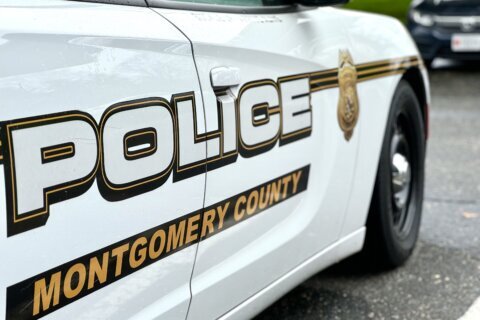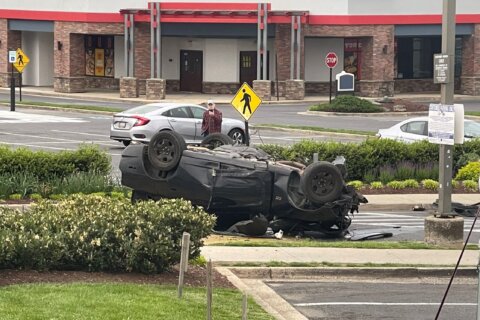From “walking school buses” to better sidewalk upkeep, Montgomery County, Maryland’s Pedestrian Master Plan has more than 100 recommendations with the goal of making it safer and more pleasant for those on foot or bike to get where they’re going.
On Tuesday, residents got their chance to tell the county council what they think of the plan.
Adam Carlesco, who lives in the Wheaton area and doesn’t own a car, spoke in favor of the plan. Among the items in the plan he especially appreciated, he said, is the recommendation to add raised crosswalks to all driveways and between some types of residential streets.
He called them the “single most important thing that this county could do to improve pedestrian safety.”
Silver Spring resident Tony Byrne also complimented the plan, explaining that he’s able to walk from his home to work, and that he loves living in Montgomery County.
“What I don’t love,” he told the council during Tuesday’s hearing, “is the persistent feeling of unsafety.”
Byrne explained that when crossing busy roads like Georgia Avenue or Seminary Road, “the pervasive feeling that I get is that, despite the great efforts of previous people working on pedestrian issues, that historically as a county we have prioritized automotive speed over pedestrian safety.”
Like several other speakers, Byrne had lots of praise for the Planning Board’s work on the pedestrian safety plan but said he expected that the county could face a lot of pushback.
He told the council the decision ahead of them could be a “politically difficult thing” to implement for the future because “people will complain immediately — this has already happened on my neighborhood Listserv.”
There were more than a dozen speakers, none as brief as Erik Herron, representing the Action Committee for Transit. He told the council in his 15-second testimony that “this is a terrific document. Don’t change of a word of it. Pass it, then implement it without delay in full.”
But there were residents who explained that while they do support added safety for pedestrians, they oppose elements of the plan.
Kimblyn Persaud, founder of Empowering People In Communities of Montgomery County (EPIC of MoCo), told the council that the plan was “written through the lens of privilege,” not from the perspective of a parent who might have to pick up a sick child from school then go to work.
“The big red flag for me is knowing the funding is not there to bring the vision to fruition,” Persaud said.
The document stated that there’s a need to “identify new revenue sources to fund pedestrian improvements.”
Included in that section of the plan are recommendations such as setting “market rates” for parking in county-operated facilities and implementing a “non-regressive tax” to fund pedestrian and safety improvements.
Michael Heyl, speaking on behalf of the Byeforde Rock Creek Highlands Citizens Association, objected to the part of the plan that would make the closure of Beach Drive from Connecticut Avenue to Knowles Avenue permanent.
That stretch of Beach Drive is already closed to automobile traffic on the weekends and holidays.
“Since April of 2020, our neighborhood has experienced a significant and unsafe [amount] of nonlocal cut through traffic whenever Beach Drive is closed,” Heyl said.
Compounding the problem, Heyl said, was the fact that his neighborhood doesn’t have sidewalks on its narrow streets with cars parked on both sides. He added that, along with blind spots in many areas, there are “no traffic calming measures of which to speak.”
The part of the plan that references closing Beach Drive and Sligo Creek Parkway stated that “Spillover effects to adjacent neighborhood streets should be studied” and that any negative impacts “should be mitigated.”
Also opposing the plan was Kensington-area resident Patricia Mulready, who said the plan was “disrespectful” to historic neighborhoods and that while envisioning the formation of walking school buses where kids and parents walk to school in large groups is “a nice idea,” it was unlikely to happen.
She also said that walking as a mode of transportation could be “miserable” given extreme seasonal weather.
One of the final speakers of the afternoon was Leia Neilson, a high school student who supports the plan.
Neilson said she often relies on taking the J2 bus from her neighborhood along Old Georgetown Road. She told the council she’d noticed the long wait times for pedestrians at the traffic lights versus the amount of time given to cars along the busy corridor.
“Pedestrians are given only 23 seconds to cross Old Georgetown which is not enough time,” she said.
She urged the council to move ahead with the plan, explaining that she is passionate about the issue “because I firmly believe that the future of Montgomery County is one with far fewer cars and far more pedestrians, bikes, buses and trains.”
After the testimony, County Council President Evan Glass said that in the first six months of 2023, “320 of our neighbors have been hit while walking or biking in our neighborhoods and nine have been tragically killed.”
The pedestrian master plan will be reviewed by the county council in the fall after its summer recess.








